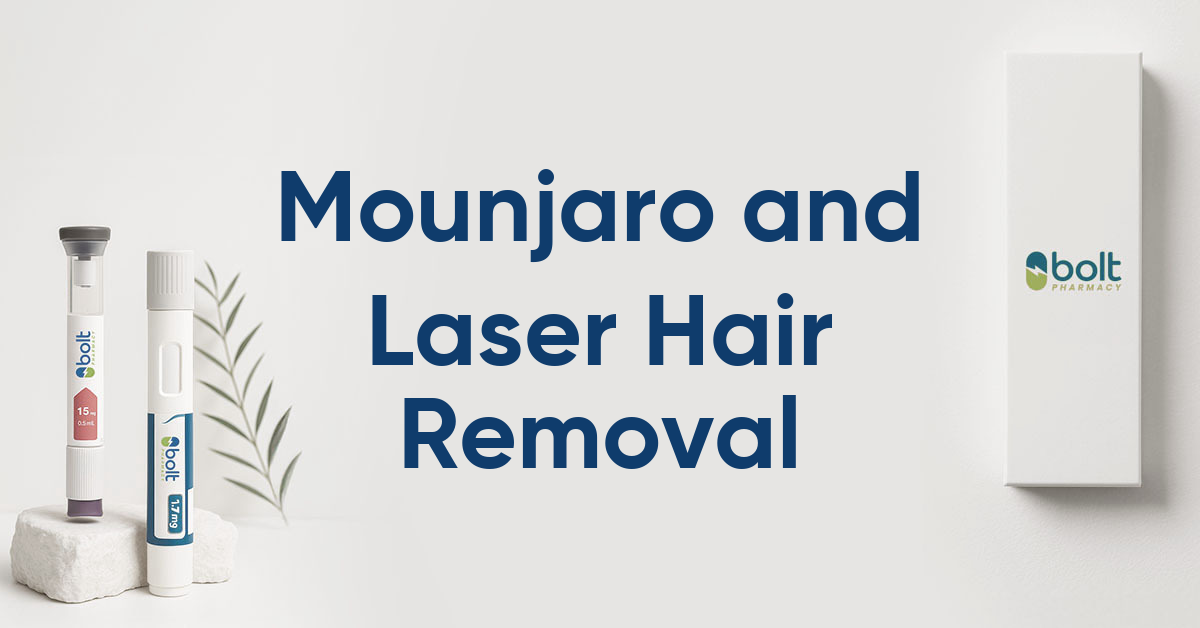
Mounjaro (tirzepatide) is a dual GIP and GLP-1 receptor agonist licensed in the UK for type 2 diabetes and weight management. Many patients considering laser hair removal whilst taking Mounjaro wonder whether the medication affects treatment safety or outcomes. Whilst the MHRA Summary of Product Characteristics does not list contraindications to laser procedures, several indirect factors warrant consideration—including metabolic changes, skin hydration, and diabetes-related complications. This article examines the evidence, practical considerations, and precautions for safely combining Mounjaro with laser hair removal treatments.
Summary: There are no documented contraindications to laser hair removal whilst taking Mounjaro, though individual patient factors such as hydration status, skin condition, and diabetes-related complications require careful assessment.
Mounjaro (tirzepatide) is a prescription medicine licensed in the UK for the treatment of type 2 diabetes mellitus and for weight management in adults with obesity or overweight with weight-related comorbidities, as per the MHRA/EMC Summary of Product Characteristics (SmPC). It belongs to a novel class of medications known as dual glucose-dependent insulinotropic polypeptide (GIP) and glucagon-like peptide-1 (GLP-1) receptor agonists. By activating both GIP and GLP-1 receptors, tirzepatide enhances insulin secretion in a glucose-dependent manner, suppresses glucagon release, slows gastric emptying, and reduces appetite—collectively leading to improved glycaemic control and significant weight loss.
Administered as a once-weekly subcutaneous injection, Mounjaro is typically initiated at a low dose (2.5 mg) and gradually titrated upwards to minimise gastrointestinal side effects. Common adverse effects include nausea, vomiting, diarrhoea, constipation, abdominal discomfort, and reduced appetite. These symptoms are usually mild to moderate and tend to diminish over time as the body adjusts to the medication. Less commonly, patients may experience injection site reactions, fatigue, or dizziness. When used with insulin or sulfonylureas, there is an increased risk of hypoglycaemia.
Importantly, tirzepatide may reduce the exposure to oral contraceptives, particularly during initiation and for 4 weeks after each dose escalation. Additional non-oral/barrier contraception is recommended during these periods. Mounjaro is not recommended during pregnancy or breastfeeding.
From a dermatological perspective, the SmPC for tirzepatide does not list any direct effects on skin structure, hair growth cycles, or wound healing. However, the significant weight loss associated with Mounjaro can lead to changes in skin laxity, hydration status, and potentially alter subcutaneous fat distribution. Additionally, any medication that affects metabolic processes may theoretically influence skin sensitivity or healing capacity, although there is currently no evidence in the SmPC or published literature establishing a link between tirzepatide and impaired skin recovery.

Laser hair removal is a widely used cosmetic procedure that employs concentrated light energy to target and destroy hair follicles, resulting in long-term hair reduction. The laser emits a specific wavelength of light that is absorbed by the melanin pigment in the hair shaft. This absorbed energy converts to heat, which damages the hair follicle and inhibits future hair growth. The procedure is most effective on individuals with dark hair and lighter skin, as the contrast allows for better targeting, though advances in laser technology have broadened its applicability across different Fitzpatrick skin types.
Multiple treatment sessions are required to achieve optimal results, as the laser can only effectively target hairs in the active growth (anagen) phase. Sessions are typically spaced according to the treatment area—approximately 4 weeks for facial areas and 6-8 weeks for body areas. Common side effects of laser hair removal include temporary redness, swelling, and mild discomfort in the treated area, which typically resolve within a few hours to days. More serious but rare complications can include burns, blistering, changes in skin pigmentation (hyperpigmentation or hypopigmentation), and scarring.
Several factors can influence the safety and efficacy of laser hair removal. Skin sensitivity, hydration status, and overall health play crucial roles in treatment outcomes and complication risk. A patch test is recommended before full treatment to assess skin reaction. Patients with certain medical conditions, those taking photosensitising medications, or individuals with compromised immune function may require special consideration.
Proper pre-treatment preparation is essential and includes:
Avoiding sun exposure and tanning products for at least four weeks before treatment
Using broad-spectrum SPF 30+ sunscreen on exposed areas
Discontinuing systemic isotretinoin for 6-12 months before treatment (follow your clinic's policy)
Avoiding waxing or plucking for 3-4 weeks before treatment
Shaving the treatment area 24 hours before the procedure
Discontinuing certain skincare products (retinoids, exfoliants) as advised
The MHRA/EMC Summary of Product Characteristics (SmPC) for Mounjaro does not list any contraindications to undergoing laser hair removal whilst taking tirzepatide, nor does it identify tirzepatide as a photosensitising agent. Established dermatological guidelines do not specifically mention tirzepatide as a medication that would preclude laser hair removal treatments. However, it's important to note that the evidence base regarding potential interactions is limited, and clinic protocols may vary.
Several indirect considerations warrant attention. The significant weight loss associated with Mounjaro can lead to changes in skin hydration, elasticity, and subcutaneous fat distribution, which may theoretically affect skin sensitivity during laser procedures. Patients experiencing rapid weight loss may have skin that is more fragile or prone to irritation. Additionally, if gastrointestinal side effects from tirzepatide lead to dehydration, this could compromise skin barrier function and potentially increase sensitivity to laser treatment.
It is also important to consider that individual patient factors—rather than the medication itself—may influence treatment safety. For instance, patients with diabetes (the primary indication for Mounjaro) may have pre-existing concerns regarding wound healing, skin integrity, diabetic neuropathy, or peripheral vascular disease that require careful assessment before proceeding with cosmetic procedures. These conditions may increase the risk of burns or delayed healing and should be evaluated before treatment.
Best practice involves open communication between the patient, their prescribing clinician, and the laser treatment provider. A thorough pre-treatment consultation should assess overall health status, medication regimen, skin condition, and any diabetes-related complications that might affect treatment safety or outcomes. Coordination between healthcare providers is particularly important for patients with diabetes complications.
When planning laser hair removal whilst taking Mounjaro, timing considerations primarily relate to the patient's overall stability on the medication rather than specific pharmacokinetic interactions. As a pragmatic clinical consideration (not a formal guideline), it is generally advisable to wait until the patient has been on a stable dose of tirzepatide for several weeks and any initial side effects—particularly gastrointestinal symptoms—have resolved or stabilised. This allows for better assessment of the patient's hydration status, skin condition, and general wellbeing before proceeding with elective cosmetic procedures.
Women using oral contraceptives should be aware that tirzepatide may reduce contraceptive exposure during initiation and for 4 weeks after each dose escalation. Additional non-oral/barrier contraception is recommended during these periods.
Patients should ensure they are adequately hydrated before and after laser treatments, as dehydration can compromise skin barrier function and potentially increase the risk of adverse effects. If experiencing significant nausea, vomiting, or diarrhoea from Mounjaro, it may be prudent to postpone laser hair removal until these symptoms have resolved. Additionally, maintaining good glycaemic control (for those using Mounjaro for diabetes management) is important, as poorly controlled blood glucose can impair wound healing and increase infection risk.
Pre-treatment precautions should include:
Informing the laser treatment provider about all medications, including Mounjaro
Undergoing a patch test to assess skin reaction
Ensuring adequate hydration in the days leading up to treatment
Avoiding sun exposure, sunbeds and tanning products for at least four weeks before treatment
Discontinuing any potentially irritating skincare products (retinoids, exfoliants) as advised
Deferring treatment if you've used systemic isotretinoin within the past 6-12 months (follow your clinic's policy)
Shaving—not waxing or plucking—the treatment area 24 hours before the procedure
Post-treatment care is equally important. Patients should follow all aftercare instructions provided by their laser technician, including applying recommended soothing products, avoiding heat exposure (saunas, hot showers, exercise), using broad-spectrum SPF 30+ sunscreen on treated areas, and protecting treated areas from sun exposure. Any signs of unusual skin reactions, delayed healing, or infection should prompt immediate contact with a healthcare provider.
Whilst no specific interactions between Mounjaro and laser hair removal have been documented in the SmPC or published literature, patients should remain vigilant for potential side effects from either the medication or the cosmetic procedure. Common side effects from laser hair removal—such as temporary redness, swelling, and mild discomfort—are generally self-limiting and resolve within hours to a few days. Applying cool compresses and using gentle, fragrance-free moisturisers can help alleviate these symptoms.
Patients should seek medical advice if they experience:
Severe or persistent pain at the treatment site that does not improve with over-the-counter analgesia
Signs of infection, including increasing redness, warmth, swelling, purulent discharge, or fever
Blistering or burns that appear more severe than expected
Changes in skin pigmentation that do not resolve within a few weeks
Delayed wound healing or any areas that fail to recover as anticipated
Unusual skin reactions that may suggest an allergic or hypersensitivity response
For severe or extensive reactions, or if you develop systemic symptoms, contact NHS 111 or seek urgent care as appropriate.
For patients using Mounjaro for diabetes management, it is important to monitor blood glucose levels regularly, as stress from any medical or cosmetic procedure can potentially affect glycaemic control. If blood glucose readings become consistently elevated or if symptoms of hyperglycaemia develop, contact your GP or diabetes care team promptly.
Additionally, if you experience worsening gastrointestinal symptoms from Mounjaro—particularly severe dehydration from vomiting or diarrhoea—this should be addressed before undergoing further laser treatments. Dehydration can compromise skin health and healing capacity.
Any suspected side effects from Mounjaro should be reported through the MHRA Yellow Card Scheme (yellowcard.mhra.gov.uk). This helps the MHRA monitor the safety of medicines and take action if necessary.
Patients should feel empowered to discuss any concerns with both their prescribing clinician and their laser treatment provider. Maintaining open communication ensures that any potential complications are identified early and managed appropriately, optimising both the safety and effectiveness of laser hair removal whilst taking Mounjaro.
Yes, there are no documented contraindications to laser hair removal whilst taking Mounjaro. However, you should inform your laser treatment provider about your medication and ensure you are adequately hydrated and stable on your dose before proceeding.
Whilst there is no formal guideline, it is advisable to wait until you are stable on your dose and any initial side effects—particularly gastrointestinal symptoms—have resolved. This allows for better assessment of your hydration status and skin condition before elective cosmetic procedures.
Ensure adequate hydration, inform your laser provider about all medications, undergo a patch test, avoid sun exposure for four weeks before treatment, and maintain good glycaemic control if using Mounjaro for diabetes. Postpone treatment if experiencing significant dehydration or gastrointestinal symptoms.
The health-related content published on this site is based on credible scientific sources and is periodically reviewed to ensure accuracy and relevance. Although we aim to reflect the most current medical knowledge, the material is meant for general education and awareness only.
The information on this site is not a substitute for professional medical advice. For any health concerns, please speak with a qualified medical professional. By using this information, you acknowledge responsibility for any decisions made and understand we are not liable for any consequences that may result.
Lorem ipsum dolor sit amet, consectetur adipiscing elit, sed do eiusmod tempor incididunt ut labore et dolore magna aliqua. Ut enim ad minim veniam, quis nostrud exercitation ullamco laboris nisi ut aliquip ex ea commodo consequat. Duis aute irure dolor in reprehenderit in voluptate velit esse cillum dolore eu fugiat nulla pariatur.
Block quote
Ordered list
Unordered list
Bold text
Emphasis
Superscript
Subscript